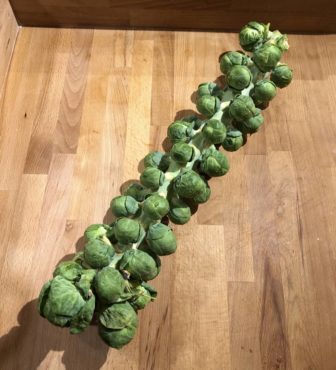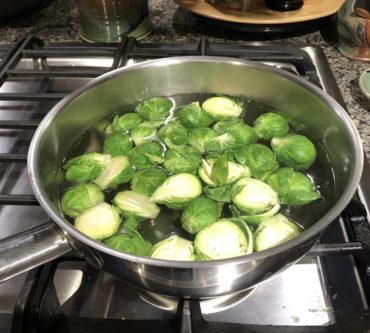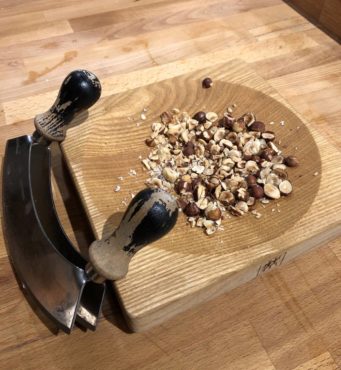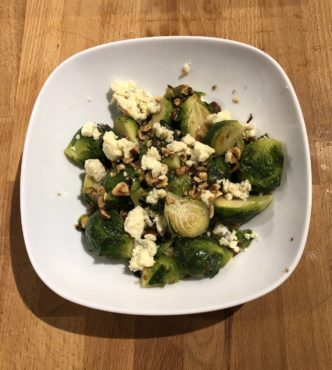 Love them or hate them, the little miniature cabbages called Brussels sprouts are prevalent in Northwest gardens and in the marketplace throughout the winter. They are an easy-to-cook, versatile and healthy addition to many recipes, from side dishes to main courses.
Love them or hate them, the little miniature cabbages called Brussels sprouts are prevalent in Northwest gardens and in the marketplace throughout the winter. They are an easy-to-cook, versatile and healthy addition to many recipes, from side dishes to main courses.
Winter is the best time to enjoy these little emerald jewels, as they sweeten on the plant with cold temperatures, are readily available and lend themselves to winter-warming seasonings.
It is thought Brussels sprouts originated in the Mediterranean along with other cabbage species, but were cultivated in the 5th century in Northern Europe and popularized in the 13th century near Brussels, Belgium — resulting in the name “Brussels sprouts.”
Traditionally, they were simply boiled or steamed and served with butter, salt and pepper, but are easy to overcook by these methods. When overcooked, the sprouts develop a mushy texture, unpleasant odor and distasteful metallic flavor, resulting in their poor reputation. With proper preparation and seasoning of the sprouts, many previous haters have been turned into aficionados.
 Internationally, Brussels sprouts are enjoyed in a variety of ways. Germans roast or sauté them with bacon and onion, cook them in beer or make a tasty soup for a cold day.
Internationally, Brussels sprouts are enjoyed in a variety of ways. Germans roast or sauté them with bacon and onion, cook them in beer or make a tasty soup for a cold day.
The French combine them with potatoes, puréeing to a creamy consistency, and serve with fish, or brown them with bacon and chestnuts or hazelnuts. They also prepare a well-known dish by sautéing in butter, with garlic, adding lemon juice and a little red pepper.
Italians add herbs, olive oil and parmesan cheese to their dishes, or pan roast them in olive oil, garlic and oregano.
In Norway, Denmark and Sweden, where winter days are very short and very cold, cabbages and Brussels sprouts are left in the garden and harvested when needed. They are frequently prepared with cream and cheese sauces for a “stick-to-your-ribs” kind of a winter meal.
As they are a cold weather vegetable, Brussels sprouts are never found in summer farmers markets. Grocers carry the frozen variety year-round, but I recommend saving your money, and only buying fresh sprouts in the winter. Frozen Brussels sprouts are partly what has contributed to their poor reputation as a desirable side dish. They tend to be bitter, waterlogged and a strange, off-green-yellowish color.
 We lived in England for many years, which is where I gained my fondness and appreciation for these sweet little “rose cabbages,” as they are sometimes called in Europe. About the first of December, long stalks of sprouts began to show up in the village markets. Intrigued by the sheer size of the stalks, attracted to the reasonable price, and knowing my husband’s fondness for them, I bought a stalk and took it home as a novelty, anticipating many meals of delicious experimentation.
We lived in England for many years, which is where I gained my fondness and appreciation for these sweet little “rose cabbages,” as they are sometimes called in Europe. About the first of December, long stalks of sprouts began to show up in the village markets. Intrigued by the sheer size of the stalks, attracted to the reasonable price, and knowing my husband’s fondness for them, I bought a stalk and took it home as a novelty, anticipating many meals of delicious experimentation.
There is a well-known recipe maven in the UK, Delia Smith, who had a weekly television show cooking traditional British foods. She also had published a cookbook as a companion to the recipes she demonstrated on her show. One of the first episodes I watched included the “proper” way to cook Brussels sprouts — proper by British standards, anyway.
Smith suggested taking off any loose outer leaves, trimming the stem and end and cutting an X into the stem. Next, covering them with boiling water and simmering for 5-7 minutes until still firm in the center when tested with a skewer. She then mentioned draining the sprouts and drizzling with butter and salt and pepper.
Today, her website has many more recipes for preparing Brussels sprouts, so check it out.
I had learned the “X” slit technique by reading Julia Childs’ “Mastering the Art of French Cooking” many years previously. Childs suggests par-cooking, or blanching, Brussels sprouts before embarking on her many recipes, which produce savory and delicious results.
I use the blanching technique to prep my sprouts for most dishes. I find it is easier to control the cooking time and it makes last-minute preparation much easier. A favorite recipe of mine is to combine halved Brussels sprouts with garlic, roasted hazelnuts and crumbled blue cheese. Used as a filling for baked sweet potatoes, we enjoy this as a warm and satisfying meatless meal during the cold months (recipe follows).
 On the subject of blue cheese — for the first time in history, an American creamery has won the World Cheese Award for the best cheese of the year! Rogue Creamery, which is located in Central Point, Oregon, just north of Medford, has produced an outstanding blue cheese that won over other entries hands down.
On the subject of blue cheese — for the first time in history, an American creamery has won the World Cheese Award for the best cheese of the year! Rogue Creamery, which is located in Central Point, Oregon, just north of Medford, has produced an outstanding blue cheese that won over other entries hands down.
Rogue River Blue was named No. 1 in the world through judging from 3,800 entries. According to the Rogue Creamery website, “Rogue River blue cheese is wrapped in grape leaves that have been macerated in pear brandy. Its forward, well-aged flavor tastes of brandy, fruit and burnt cream. A creamy, crunchy-smooth texture conjures specks of rock candy dissolving like divinity.
“The antique linen-hued paste features random tôile-styled patterns of green blue veins and the rind is gracefully imprinted by its grape leaf wrapping. The flavors of our signature terroir include hints of sweet pine, wild ripened berries, hazelnuts, morels and pears.”
It is now only available as a limited addition, and if readers would like to sample it, Fred Meyer grocery stores have a small amount in their specialty cheese sections. It runs about $45 per pound.
As Hubby’s birthday is on Christmas Day, finding him a significant birthday gift is often difficult. Reading the press releases on Rogue River Blue, I thought, “Ah-ha! Perfect gift because he loves blue cheese everything!”
Two days after the awards, Rogue Creamery was sold out (as if I would have wanted to pay that dollar amount, anyway). However, I learned in my research that the creamery also produces three other blue cheese varieties from which I could choose. The result: I gave my unsuspecting husband a whole 6.5-pound wheel of “Crater Lake Blue,” a close second for our palates.
This description comes from the Rogue creamery website: “Crater Lake Blue Cheese is aptly named after one of Oregon’s greatest natural attractions. The pronounced and vibrant blue veins striated across the creamy white paste mirror the clouds over Crater Lake. This robust blue has a silky paste bright with flavors of sweet cream, red fruit, and a sharp finish.”
Readers may look forward to many recipes containing blue cheese in the next four months, as the wrapper on the cheese says it will keep 120 days.
Brussels Sprouts with Hazelnuts and Blue Cheese
2-4 servings depending on if it is a side or main dish
Ingredients:
- 1 pound hard, green, fresh Brussels sprouts
- 1/4 tsp kosher salt
- 2 tsp olive oil
- 1-2 cloves garlic, coarsely chopped
- 1/4 cup toasted hazelnuts, coarsely chopped
- 1/4 cup crumbled blue cheese
- Salt and pepper to taste
Instructions:
Wash and trim Brussels sprouts, removing coarse outer leaves. Cut sprouts in half lengthwise.
Bring 2 quarts water and 1/4 tsp salt to boiling, add sprouts. Simmer 5-6 minutes, drain well.
Heat olive oil in nonstick skillet over medium heat, add sprouts and garlic and cook just until the sprouts just start to brown.
Add chopped hazelnuts and cook until nuts are heated through.
Turn out into a warmed bowl and sprinkle with crumbled blue cheese.
Serving suggestion: For a delicious meatless meal, use mixture to top two baked sweet potatoes. Salt and pepper as desired.





























